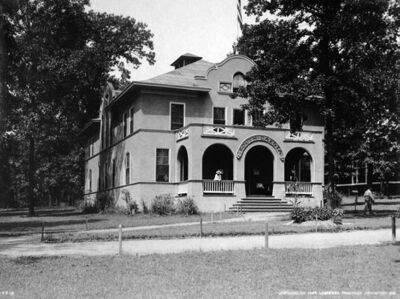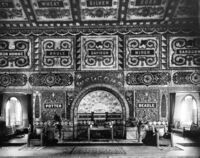South Dakota: Difference between revisions
No edit summary |
No edit summary |
||
| (4 intermediate revisions by the same user not shown) | |||
| Line 1: | Line 1: | ||
{{ | {{SHORTDESC:South Dakota State Building}} | ||
{{Infobox | {{Infobox FairBuilding | ||
| name = South Dakota State Building | | name = South Dakota State Building | ||
| image = South Dakota State Building.jpg | | image = South Dakota State Building.jpg | ||
| image_size = | | image_alt = | ||
| image_size = 400px | |||
| caption = South Dakota State Building | | caption = South Dakota State Building | ||
| alternate_name = | | alternate_name = | ||
| | | location = [[Art Hill]] | ||
| | | no_buildings = | ||
| | | construction_cost= $8,000 (${{Format price|{{Inflation|US|8,000|1904}}}} in {{Inflation/year|US}}) | ||
| furnishing_cost = | |||
| | |||
| profit = | | profit = | ||
| owner = | | owner = | ||
| | | architect = W. L. Dow & T Son, of Sioux City. | ||
| | | dimensions = 74' x 86' | ||
| | | adult_entry = | ||
| child_entry = | |||
| opening_day = | |||
| dedication_day = | |||
| special_day = | |||
| other = | | other = | ||
}} | }} | ||
South Dakota | The South Dakota building resembled an old missions in the Spanish architectural style , and was situated in a beautiful grove of trees, almost directly opposite the structure of [[Texas]] on [[Art Hill]]. | ||
==Before the Fair== | ==Before the Fair== | ||
Although one of the last of the states to procure ground for the erection of the State building, the South Dakota Building was one of the three state buildings ready to open its doors on the opening day of the Exposition. | |||
==Description== | ==Description== | ||
The building was two stories in height, having two | The building was two stories in height, having two porches on the north and west sides; the outside walls were covered with cement, finished in natural color. | ||
[[File:South_Dakota_Main_Hall.jpg|200px|thumb|left|Main Hall of South Dakota Building]] | |||
Upon entering the front door the visitor stood in the main exhibition hall 12 feet wide by 21 feet in length; with a relief map of the famous Black Hills mining region. There, the walls running through the second story to the vaulted ceiling, were covered with grains of wonderful designs and amazing colorings. The materials were corn, oats, wheat, rye, maize and flax. In a succession of panels are the names of the products of the State, and also its counties. There are heads of cattle, perfect in contour and shading, made from grain. | |||
At one end of the room, above the long narrow Spanish windows, is the State motto in grains, "Under God the People Rule." | |||
A raised dais at the side was dedicated by Sioux Falls and in the arch behind it are scenes from the town. | |||
To the right was the writing room and general business office. The walls and ceilings of all the rooms were covered with metallic sheeting with embossed designs. | |||
To the left of the main entrance, and of modern and pleasing interior decorative work, is the receiving parlor, with the portrait of the Governor of the State. There is a Conover piano in this room. | |||
The | To the rear, and through the Corn Room, was the ladies' rest room, furnished plainly and inexpensively in light greens. The striking feature there was the great painting by a South Dakota artist of ''The White Devil's Charge''. There is an interesting Indian legend told of this picture. Its heroic proportions show a mad horse, pure white in color, facing a score of armed and mounted Indians bent on its death. | ||
The second floor contained living quarters for the custodian of the building and officials. | The second floor contained living quarters for the custodian of the building and officials. | ||
A 800-seat restaurant was on premises and was available to the public. | A 800-seat restaurant was on premises and was available to the public. | ||
==See also== | ==See also== | ||
| Line 53: | Line 56: | ||
[[Category: | [[Category:Art Hill]] | ||
Latest revision as of 05:32, 1 October 2024
 | |
| Location | Art Hill |
|---|---|
| Construction | |
| Construction Cost | $8,000 ($241,274 in 2021) |
| Architecture | |
| Architect | W. L. Dow & T Son, of Sioux City. |
| Dimensions | 74' x 86' |
The South Dakota building resembled an old missions in the Spanish architectural style , and was situated in a beautiful grove of trees, almost directly opposite the structure of Texas on Art Hill.
Before the Fair[edit | edit source]
Although one of the last of the states to procure ground for the erection of the State building, the South Dakota Building was one of the three state buildings ready to open its doors on the opening day of the Exposition.
Description[edit | edit source]
The building was two stories in height, having two porches on the north and west sides; the outside walls were covered with cement, finished in natural color.

Upon entering the front door the visitor stood in the main exhibition hall 12 feet wide by 21 feet in length; with a relief map of the famous Black Hills mining region. There, the walls running through the second story to the vaulted ceiling, were covered with grains of wonderful designs and amazing colorings. The materials were corn, oats, wheat, rye, maize and flax. In a succession of panels are the names of the products of the State, and also its counties. There are heads of cattle, perfect in contour and shading, made from grain. At one end of the room, above the long narrow Spanish windows, is the State motto in grains, "Under God the People Rule." A raised dais at the side was dedicated by Sioux Falls and in the arch behind it are scenes from the town.
To the right was the writing room and general business office. The walls and ceilings of all the rooms were covered with metallic sheeting with embossed designs.
To the left of the main entrance, and of modern and pleasing interior decorative work, is the receiving parlor, with the portrait of the Governor of the State. There is a Conover piano in this room.
To the rear, and through the Corn Room, was the ladies' rest room, furnished plainly and inexpensively in light greens. The striking feature there was the great painting by a South Dakota artist of The White Devil's Charge. There is an interesting Indian legend told of this picture. Its heroic proportions show a mad horse, pure white in color, facing a score of armed and mounted Indians bent on its death.
The second floor contained living quarters for the custodian of the building and officials.
A 800-seat restaurant was on premises and was available to the public.
